|
|
|
Sort Order |
|
|
|
Items / Page
|
|
|
|
|
|
|
| Srl | Item |
| 1 |
ID:
132490
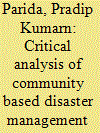

|
|
|
|
|
| Publication |
2014.
|
| Summary/Abstract |
Disaster may be de?ned as those extreme events either natural or man-induced, which exceed the tolerable magnitude within or beyond certain time limits, make adjustment dif?cult, result in catastrophic losses of property, income and lives and livelihood of people in general. Natural hazards involve comparatively high density processes and extreme events caused by both terrestrial and atmospheric processes. Where the impact of hazard is such that normal community and organizational arrangements are no longer functioning, disaster can be said to have occurred. Natural disasters take a huge toll of human lives and property and severely hamper development. It may not be possible to prevent natural disasters totally, but with careful pre-disaster planning and preparedness, we can reduce the adverse effect of the hazards and the economic loss. Here is required the signi?cance of disaster management.
|
|
|
|
|
|
|
|
|
|
|
|
|
|
|
|
| 2 |
ID:
132495
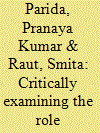

|
|
|
|
|
| Publication |
2014.
|
| Summary/Abstract |
Each day, natural disasters such as ?oods, earthquakes and hurricanes/ cyclones threaten human life and cause severe environmental losses around the world. During the last decade, disasters have affected the lives and assets of almost 2.4 billion people across the world (OCHO, 2010). In India alone since the year 2000, an average 65 million people have been affected by disasters every year. Of this, 8.45 million have been children under the age of ?ve and 3.25 million are pregnant and lactating mothers (UNICEF). Such
humanitarian crises often set back the developmental gains of lesser developed regions by several" decades. Not only do disasters lead to the loss of life and property, but "the immediate a?ermath is a complex situation complicated by issues of logistics, search and rescue, relief distribution, limited accessibility to some of the affected areas, the threat of secondary disasters, the mostly well-intentioned interests of diverse stakeholder groups (which many a times are external to the context of thedisaster), the in?ow of aid material and grants, political interest, media interest and often limited administration capacity. Government is responsible for administrative arrangements dealing with disasters.- Effective policies play a vital role in mitigating the impact of disasters and reducing likely losses of life and property ( Erramilli, 2008) . The disaster management, which is not being treated as a sector by itself, is
undergoing major changes, especially at the institutional and policy levels, which are prompted by various. macro-level factors ( Wagle and Warghade, 2006). Effective coordination among various stakeholders, specifically the Government, the international community and nongovernmental organizations (NGOS) in the aftermath of a disaster is critical to, among other things, a minimization in disaster response time, the proper allocation of resources and the avoidance of duplication of response efforts; Moreover, as economic growth and sustainable development are essential to successful disaster preparedness and mitigation efforts, effective coordination has the potential to strengthen the link between emergency response, preparedness and long-term development strategies.
|
|
|
|
|
|
|
|
|
|
|
|
|
|
|
|
| 3 |
ID:
132489
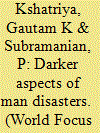

|
|
|
|
|
| Publication |
2014.
|
| Summary/Abstract |
Disaster is a term one would rather be not associated with because of the negative vibes that it sends out. The ways and means to overcome the negative-thoughts that are brought on in the wake of disaster assume a lot of importance. The consequences of disaster have such far reaching and destructive effects that we become helpless individuals running helter skelter to seek protection and also recover from the shock of disaster.
|
|
|
|
|
|
|
|
|
|
|
|
|
|
|
|
| 4 |
ID:
132497
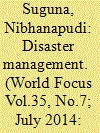

|
|
|
|
|
| Publication |
2014.
|
| Summary/Abstract |
Hundreds of Natural disasters take place worldwide every year causing irreparable damage to life and property. Earthquakes, ?oods, typhoons, hurricanes,- Tsunamis are among the worst of these natural disasters. Over the last few decades, there has been an alarming increase in the occurrence of natural disasters and the magnitude of their social, economic and environmental impact. During any natural disaster it is usually the" children who suffer the most. The nation witnessed the death of nearly a thousand children during the 2001 Bhuj earthquake. Out of them, 300 died while marching for the Republic day parade. They were in a narrow lane when the earthquake hit causing buildings onboth sides to collapse. It is said thatpnearly 1,884 school buildings collapsed leading to a loss of 5,950 class rooms. About 12000 schools suffered damages making them un?t for children to continue their studies. Fire tragedies, like the one in Kurnbakonam killed 93 children in a school. Another ?re accident in Dabwali, Haryana where a ?re broke out during a schoolfunction took he lives of many school children. Children in schools are the 'most vulnerable group during any disaster. These tragedies reiterate the need for all of us to sit up and think about the safety of these children. It is necessary to make schools safe and hazard proof. For this purpose, it is important to have disaster management, emergency preparedness and response plans at school level.
|
|
|
|
|
|
|
|
|
|
|
|
|
|
|
|
| 5 |
ID:
132496
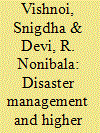

|
|
|
|
|
| Publication |
2014.
|
| Summary/Abstract |
School and higher education has received a very important place in the l2 " Plan document submitted by the working group on disaster management'. There is a paradigm shift in the approach of this document as it has not only earmarked adequate funding for school and higher education, technical education and medical education, but has for the first time tried to use the human resources in a fruitful manner. While the 12"education lists major initiatives which needs to be taken, it has yet to specify the road map for successful. implementation of the recommendations outlining speci?c roles that various stakeholders may play. The Department of Anthropology, University of Delhi, organized a one day seminar to critically examine the document of 12* Five Year Plan with special reference to the 'role of higher education in disaster management.' Ahumble introduction of the chairperson Prof. Vinay Kumar Srivastava, former Principal, Hindu College, and other distinguished speakers, which included Prof. R. B. Singh, Vice President International - Geography Union; Dr. Ranjana Mukhpadhyay, Chairperson, Samutthan Eoundation; Dr Urfat Anjem Mir, Ambedkar University, New Delhi; Dr. Angeli Qwatra, Philanthrope, New Delhi; Dr. Sunita Reddy, Jawaharlal Nehru_University; Prof. V. R. Rao, former Director, Anthropological Survey of India was provided to the audience sharing the expertise and interests of each one of them. Prof. P.C Joshi, Asia Coordinator, EU Integrated Project MICRODIS and President, Society for Indian Medical Anthropology, initiatedthe discussion by sharing the concern of thinking of ways of mainstreaming disaster education at various levels and cadres. It was emphasized to discuss the role and capacities of universities in particular to impart awareness, and support action towards the -same.
|
|
|
|
|
|
|
|
|
|
|
|
|
|
|
|
| 6 |
ID:
132494
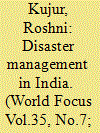

|
|
|
|
|
| Publication |
2014.
|
| Summary/Abstract |
Development and welfare of human beings is intimately related to the natural environment. Normally, environment is a source of livelihood but at times due to the intensive intervene made by human it brings
hazards like earthquake, cyclone, ?ood, landslide etc. further these hazards turns into disasters causing losses of life and property.' These hazards can be minimized by using modern scientific and technological
advancements. Disaster is a sudden adverse or unfortunate extreme event which causes great damage to human beings as well as plants and animals. Disasters I occur rapidly, instantaneously and indiscriminately which wipe out the years of development in a matter of hours. Disaster may be natural or man-made chaos and destruction reigns everywhere. It doesn't only justify initial death and damage occurrence but even the post-disaster tranquility and sufferings that too without any doubt regenerate pain and misery. Around 76% of India's coastline is prone to cyclones and tsunamis, while 59% of the country is vulnerable to earthquakes, 10% to-?oods and river erosion, and 68 %_to droughts? This has been stated by National Policy on Disaster Management that, "Disaster disruptsprogress and destroys the hard earned fruits of painstaking developmental efforts, often pushing nations, in to the quest for progress, back by several decades. Thus ef?cient management of disasters rather than mere response to their occurrence has in recent days received increased attention both in -India and abroad. This is as much a result of the recognition of the increasing frequency and intensity of disasters as it is an acknowledgement that good governance, in a caring and civilized society, needs to deal effectively with the devastating impact of disasters?"
|
|
|
|
|
|
|
|
|
|
|
|
|
|
|
|
| 7 |
ID:
132486
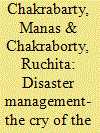

|
|
|
|
|
| Publication |
2014.
|
| Summary/Abstract |
One of the most crucial problems-with which mankind confronted with is de?nitely the ways and means of disaster management. In fact, mankind has survived and lived with natural disasters right from the days of the mythical universal deluge. (N arayan 2000). Many a times, mankind becomes simply a toy in the ands of the nature when it becomes furious due to ?ood or earthquake. Floods, volcanic eruptions and earthquakes have plagued and devastated humanity since time immemorial. (Narayan, 2000). The number" of natural disasters around the world continues to grow over time, and their impact on the stricken regions continues to be worsening. (Singh, 2000) In such situations, disaster management becomes really a major concern. Disaster management has assumed great importance of late, due to the occurrence of natural as well as manmade disasters. (Murthy, 2007).
|
|
|
|
|
|
|
|
|
|
|
|
|
|
|
|
| 8 |
ID:
132498
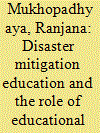

|
|
|
|
|
| Publication |
2014.
|
| Summary/Abstract |
Disasters are increasing exponentially. The number of disaster events which was 73 in 1900-09 has increased to 4494 during 2000-09. More people were affected in the two recent decades than the earlier ones. During the second half of the 20th century, more than 200 major natural disasters occurred in different parts of the world and claimed the lives of around 1.4 million people. In 2011 alone, 302 hazards resulted in disasters that claimed almost 30,000 lives, affected 206 million people and in?icted damages worth an estimated USS 366 billion, according to the United Nations Office for Disaster Risk Reduction.
|
|
|
|
|
|
|
|
|
|
|
|
|
|
|
|
| 9 |
ID:
132501
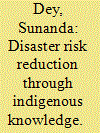

|
|
|
|
|
| Summary/Abstract |
Disasters occur at the interface of society, technology and environment and are fundamentally the outcomes' of the interaction. of these features. In very graphic ways, disasters signal the failure of a society to adapt successfully to certain features of its natural and socially constructed environment in a sustainable fashion (Smith and Hoffman, 2002).
|
|
|
|
|
|
|
|
|
|
|
|
|
|
|
|
| 10 |
ID:
132502
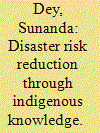

|
|
|
|
|
| Summary/Abstract |
Disasters occur at the interface of society, technology and environment and are fundamentally the outcomes' of the interaction. of these features. In very graphic ways, disasters signal the failure of a society to adapt successfully to certain features of its natural and socially constructed environment in a sustainable fashion (Smith and Hoffman, 2002).
|
|
|
|
|
|
|
|
|
|
|
|
|
|
|
|
| 11 |
ID:
132503
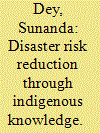

|
|
|
|
|
| Publication |
2014.
|
| Summary/Abstract |
Disasters occur at the interface of society, technology and environment and are fundamentally the outcomes' of the interaction. of these features. In very graphic ways, disasters signal the failure of a society to adapt successfully to certain features of its natural and socially constructed environment in a sustainable fashion (Smith and Hoffman, 2002).
|
|
|
|
|
|
|
|
|
|
|
|
|
|
|
|
| 12 |
ID:
132499
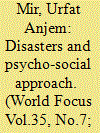

|
|
|
|
|
| Publication |
2014.
|
| Summary/Abstract |
Disasters both manmade as well as natural often result in great physical and material loss for the affected communities, besides affecting the social, physical and psychological well-being of the survivors in its aftermath. It has been seen that disasters have an adverse impact on the survival, dignity and livelihoods of individuals and communities, particularly of the poor, in both developed and less developed countries. There are multiple factors which have been attributed as causes of these extreme events, like environmentally unsound practices, global climatic changes, population growth, urbanization, social injustice, poverty etc. However, when it comes to comprehension of disasters in contemporary times, there is a need to look at disaster as social phenomena. This is precisely, with regard to man- nature relationship discourse. While explaining this relationship, Kroeber (1939 p1), rightly writes, ' while it is true that cultures are rooted in nature, and can therefore never be understood except with reference to that piece of nature in which they occur, they are no more produced by that nature thana plant" is produced or caused by the soil in which it is rooted. The immediate causes of cultural phenomena are other cultural phenomena.
|
|
|
|
|
|
|
|
|
|
|
|
|
|
|
|
| 13 |
ID:
132500
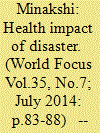

|
|
|
|
|
| Publication |
2014.
|
| Summary/Abstract |
Gender and Health Issues in Disaster: Disasters are traumatic events that are experienced by many
people and may result in a wide range of mental and physical health consequences (Norris, Friedman,
Watson, et al., 2002). The resulting impacts from disasters are frequently more severe on women and
girls than those of their male counterparts and women's physical, reproductive and mental health needs, along with other facets of women's lives,.have largely been ignored in the whole process (Laska et al., 2008). According to WHO, there is pattern of gender differentiation at all level of disaster process: exposure ' to risk, risk perception, preparedness, response, physical impact, psychological impact, recovery and reconstruction and there is evidence showing that women and men may sufferdifferent negative health consequences after the disaster (WHO, 2002). However, it is not clear whether this is due to biological differences between the sexes, because of socially determined differences in women's and men's roles and status or because of the interaction of social and biological factors (WHO, 2002).
|
|
|
|
|
|
|
|
|
|
|
|
|
|
|
|
| 14 |
ID:
132485
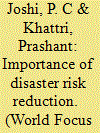

|
|
|
|
|
| Publication |
2014.
|
| Summary/Abstract |
Disasters are occurring globally. Developed as well as developing countries, are being affected by the catastrophic consequences of both natural and human- made disasters. According to the CRED', in 2013 alone the total number of natural disasters amount to around 334 events worldwide causing 22,616 deaths and around 97 million "affected people. The economic damages due to disasters was to the tune of 118 billion US $ last year. 2013 was also a very harsh year for Asia as'88 percent of the mortalities were reported from this continent which was far more than the decadal (2003-2012) average of 62 percent. India, in particular" ranked second in the world with 7,368 deaths; third with 16.7 million people affected due to disasters and ranked eighth with an economic _loss of 2.4 billion US S. Besides these ?gures there are disasters that. have, made international news recently for example the 2011 Japanese Tsunami and the consequent nuclear emergency in the Fukushima Nuclear Plant. In the Indian context we are still living with the vivid memories of disasters like the Bhopal Gas Tragedy, Gujarat" Earthquake, Orissa Super Cyclone, Indian Ocean Tsunami, Kashmir Earthquake, Kosi Floods and Cyclone Aila. India is also prone to several other kinds of disasters and a large land mass is vulnerable to natural hazards.
|
|
|
|
|
|
|
|
|
|
|
|
|
|
|
|
| 15 |
ID:
132484
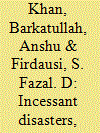

|
|
|
|
|
| Publication |
2014.
|
| Summary/Abstract |
The study of disasters requires at the outset an understanding of the geographic variability in' the hazards and their impacts; the geographic variability in populations at risk; the vulnerability of population and the context in which these three interact. It is imperative to ?rst understand the meaning of the terms disasters, hazard, risk and vulnerability.
|
|
|
|
|
|
|
|
|
|
|
|
|
|
|
|
| 16 |
ID:
132493
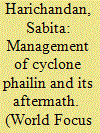

|
|
|
|
|
| Publication |
2014.
|
| Summary/Abstract |
Phailin, a tropical cyclone with wind speed of 220 kmph hit Odisha coast on 12 October 20l3,leaving
a trail of destruction. Tropical cyclone is a storm system characterized by a low pressure centre which produces a.strong wind and ?ooding rain. Tropical cyclones are named to provide easy communication between forecasters and the public. Phailin represented the second-stronger tropical cyclone after 1999 Super Cyclone. There is no gainsaying the fact that Odisha with a coastline of 4801-cm is prone to natural disasters like tropical cyclones, storm surge, whirl wind, tsunami and rain-induced ?oods on account of its sub-tropical littoral location. The 480 Km. long coastline of Odisha extends from Balasore in the North to Ganjam Coast in the South. These natural hazards cause immense damage to life and property. According to reports of Indian Meteorological Department (IMD), total number of cyclonic storms and severe cyclonic storms crossing Odisha coast between 1891 to 2000 was 98 while 69, 79 and 62 cyclones struck the coasts of West Bengal, Andhra Pradesh and Tamil Nadu respectively. Super Cyclone of 1999 devastated 14 districts of Odisha with 'catastrophic human consequences.
|
|
|
|
|
|
|
|
|
|
|
|
|
|
|
|
| 17 |
ID:
132504


|
|
|
|
|
| Publication |
2014.
|
| Summary/Abstract |
The world is a vulnerable place. It is vulnerable to a "long list of disasters that natureisfury unleashes from time to time to remind us of our mortal and transitory presence on this planet. Planet Earth, were she 'to voice her opinion, and if someone were prepared to listen, may be tempted to add even man to this long list of disasters she has to endure. " '
|
|
|
|
|
|
|
|
|
|
|
|
|
|
|
|
| 18 |
ID:
132487
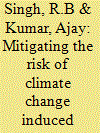

|
|
|
|
|
| Publication |
2014.
|
| Summary/Abstract |
The world's climate is continuing to change at rates that are projected to be unprecedented in recent human history. The risks of climate change and extreme climatic events such as drought and ?ood have dramatic impacts on economy and natural systems. Agriculture, livestock and water resources are among the most vulnerable systems. Resilience and adaptive capacity of traditional networks and land use systems to cope with climate variability/extremes are weakening, while ' frequency and magnitude of climate variability and land use intensity are in rise. Thus it is important to take timely action in order to reduce the risk of climate change.
|
|
|
|
|
|
|
|
|
|
|
|
|
|
|
|
| 19 |
ID:
132488
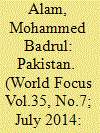

|
|
|
|
|
| Publication |
2014.
|
| Summary/Abstract |
Like in any nuclear weapon state, multiple vulnerabilities exist in a nuclear weapons complex. In the case of Pakistan, it is possible that groups or individuals may violate security rules for a variety of reasons, including pro?t making, settling a vendetta, or religious or ideological motives. Rogue elements may try to gain control over sensitive items for their own use or to transfer these items to another state or to other non-state actors for ?nancial or ideological reasons. A special concern is that of Pakistan, as its history_ suggests, may suffer another military coup at some point of time. A new leadership, in that case, can be expected to- place a high priority on seizing the country's nuclear assets
|
|
|
|
|
|
|
|
|
|
|
|
|
|
|
|
| 20 |
ID:
132492
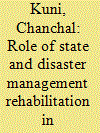

|
|
|
|
|
| Publication |
2014.
|
| Summary/Abstract |
Disaster Management is the discipline of dealing with and avoiding risks. It is a discipline that involves preparing for disaster before it occurs, disaster response (e.g. emergency evacuation, quarantine, mass decontamination, etc.), as well as supporting, and rebuilding society after natural or human-made disasters have occurred. In general, any disaster management is the continuous process by which all individuals, groups, and communities manage hazards in an effort to avoid or ameliorate the impact of disasters resulting from the hazard. Disaster and emergencies appears to be as inevitable as taxes; so too is our on-going effort to cope with them. The ability to cope lies" deep in our primordial past, which has taught us that "organising" is the most efficient and effective means to survive. Sometime due to major accident and leakage the situation become worst for the nearby peoples.
|
|
|
|
|
|
|
|
|
|
|
|
|
|
|
|
|
|
|
|
|